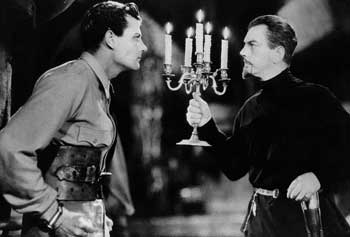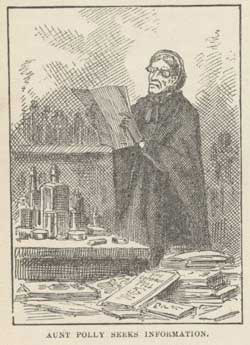
Source: The Most Dangerous Game (1932), Wikimedia
When writing your own fiction, you may have been told to “show not tell.” Well, as we discussed in the previous section, when an author reveals a character directly, he or she tells the reader exactly what the character is like. Authors also use indirect characterization to show the reader what the character is like. Indirect characterization refers to ways the author reveals the traits of a character without explicitly stating them.
Indirect characterization through speech
A character is revealed by what he or she says and by what other characters say about the character. For example, in “The Most Dangerous Game” by Richard Connell, a famous hunter, Rainsford, is lost at sea and washes ashore on an island owned by General Zaroff. We (and Rainsford) learn something extremely important about the general through his dialogue.
“I wanted the ideal animal to hunt,” explained the general. “So I said, ‘What are the attributes of an ideal quarry?’ And the answer was, of course, ‘It must have courage, cunning, and, above all, it must be able to reason.’
“But no animal can reason,” objected Rainsford. “My dear fellow,” said the general, “there is one that can.”
“But you can’t mean—a” gasped Rainsford.
“And why not?”
“I can’t believe you are serious, General Zaroff. This is a grisly joke.”
“Why should I not be serious? I am speaking of hunting.”
“Hunting? Great Guns, General Zaroff, what you speak of is murder.”
We learn two important things about the main characters through this dialogue. First, we learn that Zaroff hunts people for sport. We also learn that Rainsford is horrified by this idea (and rightly so). If the author had revealed this through direct characterization, this information would not have nearly the same impact on the reader. When we learn about characters through indirect characterization, the writer usually gives us some time to think about what we have just learned. We are able to make some decisions about the character without being told to think in a particular way about a character. Indirect characterization also allows the reader and the other characters to learn about a particular character at the same time.
Indirect characterization through thoughts
We can also learn about a character through his or her thoughts or feelings. In the previous section, we read a direct characterization from “A Cap for Steve.” We learned that Dave Diamond may have trouble providing for his family. Later in the story, Steve is offered twenty dollars for his prized Phillies cap. Dave thinks the following:
That much money for a cap, Dave thought, and his eyes brightened. But, he knew what the cap had meant to Steve; to deprive him of it now that it was within his reach would be unbearable. All the things he needed in his life gathered around him; his wife was there, saying he couldn’t afford to reject the offer, he had no right to do it; and he turned to Steve to see if Steve thought it wonderful that the cap could bring them twenty dollars.
Dave’s thoughts show that he is conflicted about taking the money. He’s trying to convince himself that taking the money is the best thing, even telling himself that his wife would tell him to take the money (though she wouldn’t). This characterization is related to what we have already read about Dave: He is so money-minded he would sacrifice his relationship with his son for a little extra cash.
Indirect characterization through actions
You can also learn about a character by what he or she does and how the character behaves. In “A Cap for Steve,” Dave allows himself to sell his son’s happiness. What does this tell you about the character? Do the characters’ actions oppose what the character thinks and says?

Source: Monday April 6th - Opening Day, [Clint], Flickr
Indirect characterization through a character’s effects on others
How other characters react to the character or what they say or think about a character contributes to our understanding of the character. In “A Cap for Steve,” Dave reacts to the rich man’s offer to sell the cap back to Steve for what his son paid for it.
Dave is intimidated by Mr. Hudson’s shrewdness and Hudson’s ability to figure him out. Through Dave’s reaction to him, we understand that Mr. Hudson will do whatever he can to get the cap for his son:
Mr. Hudson’s smile was kindly, but his eyes were shrewd, and Dave knew the lawyer was counting on his not having the two dollars; Mr. Hudson thought he had Dave sized up; he had looked at him and decided he was broke.

Source: GregoryAntonBurgundySmokingJacket,
Liftarn, Wikipedia
In “The Most Dangerous Game,” the belief that the general holds—that humans provide the best hunting challenge—horrifies the listening Rainsford. This gives readers permission to be horrified as well.
Indirect characterization through looks
We also learn about a character through what the character looks like and how the character lives and dresses. Mr. Hudson is described as wearing a brown-velvet smoking jacket, something that Dave has never seen anywhere but in a department-store window. This shows us that Mr. Hudson has enough money to spend on luxuries. The writer describes Dave as wearing an old windbreaker. This seems to tells us about Dave and his financial situation, which contrasts with that of Mr. Hudson. A character’s hair color, how tall or short, how fat or thin, and whether the character is attractive or not, all make for a more rounded picture for the reader.
Now you’re going to read a short excerpt from the first chapter of Tom Sawyer. Pay attention to how author Mark Twain uses indirect characterization. When you have read the excerpt, complete the interactive that follows.
Hint: When Aunt Polly speaks at the end of the piece, she is talking to herself. You may say those are her thoughts even though she is speaking out loud.

Source: Tom Sawyer - 12-108, True Williams, Wikimedia
“Tom!”
No answer.
“What’s gone with that boy, I wonder? You Tom!”
No answer.
The old lady pulled her spectacles down and looked over them about the room; then she put them up and looked out under them. She seldom or never looked through them for so small a thing as a boy; they were her state pair, the pride of her heart, and were built for “style,” not service—she could have seen through a pair of stove-lids just as well. She looked perplexed for a moment, and then said, not fiercely, but still loud enough for the furniture to hear: “Well, I lay if I get hold of you I’ll—” She did not finish, for by this time she was bending down and punching under the bed with the broom, and so she needed breath to punctuate the punches with. She resurrected nothing but the cat. “I never did see the beat of that boy!”
She went to the open door and stood in it and looked out among the tomato vines and “jimpson” weeds that constituted the garden. No Tom. So she lifted up her voice at an angle calculated for distance and shouted:
“Y-o-u-u Tom!”
There was a slight noise behind her and she turned just in time to seize a small boy by the slack of his roundabout and arrest his flight.
“There! I might ‘a’ thought of that closet. What you been doing in there?”
“Nothing.“
“Nothing! Look at your hands. And look at your mouth. What is that truck?”
“I don’t know, aunt.“
“Well, I know. It’s jam—that’s what it is. Forty times I’ve said if you didn’t let that jam alone I’d skin you. Hand me that switch.”
The switch hovered in the air—the peril was desperate—
“My! Look behind you, aunt!”
The old lady whirled round, and snatched her skirts out of danger. The lad fled on the instant, scrambled up the high board-fence, and disappeared over it.
His aunt Polly stood surprised a moment, and then broke into a gentle laugh.
“Hang the boy, can’t I never learn anything? Ain’t he played me tricks enough like that for me to be looking out for him by this time? But old fools is the biggest fools there is. Can’t learn an old dog new tricks, as the saying is. But my goodness, he never plays them alike, two days, and how is a body to know what’s coming? He ’pears to know just how long he can torment me before I get my dander up, and he knows if he can make out to put me off for a minute or make me laugh, it’s all down again and I can’t hit him a lick. I ain’t doing my duty by that boy, and that’s the Lord’s truth, goodness knows. Spare the rod and spile the child, as the Good Book says. I’m a laying up sin and suffering for us both, I know. He’s full of the Old Scratch, but laws-a-me! he’s my own dead sister’s boy, poor thing, and I ain’t got the heart to lash him, somehow. Every time I let him off, my conscience does hurt me so, and every time I hit him my old heart most breaks. Well-a-well, man that is born of woman is of few days and full of trouble, as the Scripture says, and I reckon it’s so. He’ll play hookey this evening, and I’ll just be obleeged to make him work, to-morrow, to punish him. It’s mighty hard to make him work Saturdays, when all the boys is having holiday, but he hates work more than he hates anything else, and I’ve got to do some of my duty by him, or I’ll be the ruination of the child.”
To see how we learn so much about Aunt Polly's character in this passage, decide what method of indirect characterization Twain is using for each quotation that appears. Choose your responses from the drop-down menus. Remember, you can learn about characters indirectly through their effects on others and through their speech, actions, thoughts, and physical characteristics (looks).
